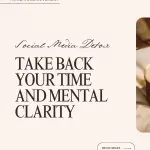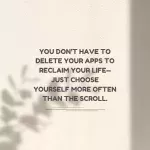Ever feel like your mind is always buzzing, your attention span shrinking, and your peace slowly eroding? You’re not alone. Millions of Americans are grappling with the side effects of constant scrolling, algorithm-driven content, and a pressure to always be online. While social media has its benefits, unchecked usage can drain our energy, erode our productivity, and disrupt our emotional and mental well-being. That’s where a social media detox comes in.

A social media detox isn’t about giving up technology or disappearing forever. It’s about reclaiming your time, setting healthy boundaries, and nurturing a sense of digital wellness that helps you thrive in both your online and offline life.
In this article, you’ll learn:
- The warning signs that it might be time for a social media detox
- The mental, emotional, and physical benefits of unplugging
- Simple steps to begin your own detox without feeling overwhelmed
- How to maintain mental clarity and build lasting digital habits
- Real tools, apps, and strategies to support your journey
Is It Time for a Social Media Detox?

Before you can change your relationship with social media, you need to identify whether it’s affecting you more than you realize. Here are some common signs that it might be time for a reset:
Red Flags of Digital Overload
- Constant comparison: You feel less confident or happy after browsing social feeds.
- Sleep disruption: You scroll late into the night or check your phone first thing in the morning.
- Reduced productivity: Social media eats into your work or creative time.
- Emotional fatigue: You feel drained, anxious, or irritable after being online.
- Mindless scrolling: You catch yourself opening apps without a clear reason.
If even a few of these sound familiar, your brain may be signaling that it needs space. A social media detox can give your nervous system a much-needed break and restore your sense of peace.
The Benefits of a Social Media Detox

Stepping back from social platforms isn’t just trendy—it’s transformational. Here’s what you can gain when you log out with intention:
Improved Mental Clarity and Focus
Without constant digital noise, your brain can finally breathe. You’ll find it easier to concentrate, retain information, and engage in meaningful tasks.
Restored Emotional Balance
Social comparison and doomscrolling contribute to anxiety, depression, and low self-esteem. A detox gives you space to reconnect with yourself without external influence.
Better Sleep and Energy Levels
Blue light and mental stimulation from screens can wreak havoc on sleep cycles. Cutting back on social media before bed can lead to deeper rest and improved energy.
Stronger In-Person Connections
With fewer digital distractions, you’ll have more presence and engagement in real-world conversations and relationships.
How to Start Your Social Media Detox

The idea of disconnecting might feel overwhelming—but it doesn’t have to be. Start small and build from there.
Set your intention
Take a few minutes to reflect on why you’re choosing to detox. Are you looking to feel more present? Do you want to reduce anxiety or reclaim your time? When you’re clear on your “why,” it becomes easier to stay committed.
Choose your timeframe
Begin with a realistic goal—maybe 24 hours, a weekend, or a full week offline. Even a short break can help reset your habits and improve your mood.
Turn off notifications
Disable alerts from all social apps. This minimizes the urge to check your phone constantly and gives your brain a chance to relax without constant interruption.
Move apps off your home screen
Hide or delete social media apps temporarily. Making them harder to access helps break the autopilot habit of checking them without thinking.
Tell others
Let your friends, family, or followers know you’re taking a break. This creates accountability and sets clear expectations, so you’re less likely to be pulled back in.
Replace the habit
Identify the moments when you usually scroll—and swap them with something more nourishing. Read a book, take a walk, meditate, journal, or connect with someone face-to-face. These healthy substitutions reinforce your decision and help build better routines.
How to Maintain Digital Wellness Long-Term

Doing a detox is only the beginning. To stay balanced, you’ll need ongoing habits that support your digital wellness.
Weekly Check-Ins
Block 10 minutes each Sunday to review your screen time and reflect on how you feel. Adjust where needed.
Curate Your Feed
Unfollow accounts that trigger comparison or drain your energy. Follow those that inspire, educate, or make you feel grounded.
Set Digital Boundaries
- No phones during meals
- Social media-free mornings or evenings
- Tech-free zones in your home (like the bedroom)
Pro Tip
Use your phone’s “Downtime” or “Focus Mode” to limit app usage during your most important hours.
Reconnect With What Matters

Social media isn’t inherently bad. But if it’s pulling you away from what truly matters—your peace, your purpose, your people—then it’s time to reset.
A social media detox is a gift you give yourself. It’s an act of courage in a world built for distraction. It restores your ability to think clearly, live presently, and love more deeply—all while regaining your most precious resources: time, energy, and mental clarity.
Go On A Social Media Detox Today
A healthier digital life starts with one simple choice: unplug with intention.
You don’t have to quit forever—but taking space can help you reclaim focus, elevate your energy, and rebuild your relationship with tech from a place of self-respect.
Ready to try your own social media detox?
Start with just one day. Notice what shifts. Your peace is worth protecting.
Share this article with someone who needs a break—and don’t forget to bookmark it for the days you need a reminder, too.











Leave a Reply